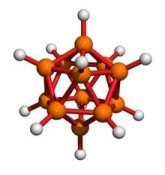Abstract23

Inorg. Chem., 37 (9), 2166 -2176, 1998. ic971395z S0020-1669(97)01395-5
Web Release Date: April 15, 1998
Gas-Phase Reaction of Tetraborane(10) and Ethyne: Molecular Structure of nido-1,2-C2B3H7 in the Gas Phase
Mark A. Fox, Robert Greatrex,* and Alireza Nikrahi
School of Chemistry, University of Leeds, Leeds, LS2 9JT, U.K.
Paul T. Brain, Matthew J. Picton, David W. H. Rankin,* and Heather E. Robertson
Department of Chemistry, University of Edinburgh, West Mains Road, Edinburgh, EH9 3JJ, U.K.
Michael Bühl
Institüt fur Organische Chemische, Universität der Zürich, Winterthurerstrasse 190, CH-8057, Zürich, Switzerland
Linda Li and Robert A. Beaudet
Department of Chemistry, University of Southern California, University Park, Los Angeles, California 90089-0482
Received November 6, 1997
Abstract:

The molecular structure of nido-1,2-C2B3H7, 1, the principal volatile carborane generated in the quenched gas-phase reaction of B4H10 and ethyne at 70 C, has been determined by a combined analysis of gas-phase electron-diffraction data and rotation constants restrained by ab initio computations at the CCSD(T)/TZP’ level. The structure is consistent with a geometry having Cs symmetry, similar to that of pentaborane(9). The apical position is occupied by a carbon atom, displaced toward B(4) from a position directly above the B(5)···B(3) vector, and hydrogen atoms asymmetrically bridge the B-B bonds. The basal atoms are almost coplanar, C(2) lying ca. 2![]() below the B(3)-B(4)-B(5) plane. Important experimental structural parameters (r
below the B(3)-B(4)-B(5) plane. Important experimental structural parameters (r![]() /pm,
/pm, ![]() /
/![]() ) are r[C(1)-C(2)] = 162.6(6); r[C(1)-B(3)] = 161.4(3); r[C(2)-B(3)] = 154.3(2); r[C(1)-B(4)] = 157.4(5); r[B(3)-B(4)] = 185.7(3); <B(3)-B(4)-B(5) = 80.9(1). In addition to this and the other previously reported carboranes, 2,3-C2B4H8, 2-Me-2,3,4-C3B3H6, and 4-Me-2-CB5H8, several new derivatives have been identified among the volatile products. These include the dicarbahexaboranes 2,4-Me2-2,3-C2B4H6 and 5-Et-2,3-C2B4H7 (the major volatile products obtained when the reaction is allowed to go to completion, previously reported as tricarbahexaboranes) and the derivatives 2,5-Me2-2,3-C2B4H6, 4-Et-2,3-C2B4H7, 1-Me-2,3,4-C3B3H6, 2-Me-2-CB5H8, 3-Me-2-CB5H8, and 2,3,4,5-C4B2H6. The complex mechanism of the reaction is discussed in light of these new results.
) are r[C(1)-C(2)] = 162.6(6); r[C(1)-B(3)] = 161.4(3); r[C(2)-B(3)] = 154.3(2); r[C(1)-B(4)] = 157.4(5); r[B(3)-B(4)] = 185.7(3); <B(3)-B(4)-B(5) = 80.9(1). In addition to this and the other previously reported carboranes, 2,3-C2B4H8, 2-Me-2,3,4-C3B3H6, and 4-Me-2-CB5H8, several new derivatives have been identified among the volatile products. These include the dicarbahexaboranes 2,4-Me2-2,3-C2B4H6 and 5-Et-2,3-C2B4H7 (the major volatile products obtained when the reaction is allowed to go to completion, previously reported as tricarbahexaboranes) and the derivatives 2,5-Me2-2,3-C2B4H6, 4-Et-2,3-C2B4H7, 1-Me-2,3,4-C3B3H6, 2-Me-2-CB5H8, 3-Me-2-CB5H8, and 2,3,4,5-C4B2H6. The complex mechanism of the reaction is discussed in light of these new results.
